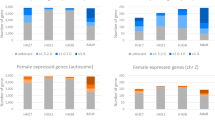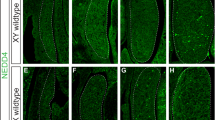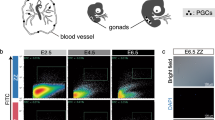Abstract
Sex in birds is chromosomally based, as in mammals, but the sex chromosomes are different and the mechanism of avian sex determination has been a long-standing mystery1,2,3. In the chicken and all other birds, the homogametic sex is male (ZZ) and the heterogametic sex is female (ZW). Two hypotheses have been proposed for the mechanism of avian sex determination. The W (female) chromosome may carry a dominant-acting ovary determinant4,5,6. Alternatively, the dosage of a Z-linked gene may mediate sex determination, two doses being required for male development (ZZ)7,8. A strong candidate avian sex-determinant under the dosage hypothesis is the conserved Z-linked gene, DMRT1 (doublesex and mab-3-related transcription factor 1)9,10,11. Here we used RNA interference (RNAi) to knock down DMRT1 in early chicken embryos. Reduction of DMRT1 protein expression in ovo leads to feminization of the embryonic gonads in genetically male (ZZ) embryos. Affected males show partial sex reversal, characterized by feminization of the gonads. The feminized left gonad shows female-like histology, disorganized testis cords and a decline in the testicular marker, SOX9. The ovarian marker, aromatase, is ectopically activated. The feminized right gonad shows a more variable loss of DMRT1 and ectopic aromatase activation, suggesting differential sensitivity to DMRT1 between left and right gonads. Germ cells also show a female pattern of distribution in the feminized male gonads. These results indicate that DMRT1 is required for testis determination in the chicken. Our data support the Z dosage hypothesis for avian sex determination.
This is a preview of subscription content, access via your institution
Access options
Subscribe to this journal
Receive 51 print issues and online access
$199.00 per year
only $3.90 per issue
Buy this article
- Purchase on Springer Link
- Instant access to full article PDF
Prices may be subject to local taxes which are calculated during checkout





Similar content being viewed by others
References
Ellegren, H. Evolution of the avian sex chromosomes and their role in sex determination. Trends Ecol. Evol. 15, 188–192 (2000)
Mizuno, S. et al. Z and W chromosomes of chickens: studies on their gene functions in sex determination and sex differentiation. Cytogenet. Genome Res. 99, 236–244 (2002)
Smith, C. A., Roeszler, K. N., Hudson, Q. J. & Sinclair, A. H. Avian sex determination: what, when and where? Cytogenet. Genome Res. 117, 165–173 (2007)
Smith, C. A. Avian sex determination: HINTS from the W sex chromosome? Sex. Dev. 1, 278–285 (2007)
Arlt, D., Bensch, S., Hansson, B., Hasselquist, D. & Westerdahl, H. Observation of a ZZW female in a natural population: implications for avian sex determination. Proc. R. Soc. Lond. B 271 (Suppl. 4). 249–251 (2004)
Hori, T., Asakawa, S., Itoh, Y., Shimizu, N. & Mizuno, S. Wpkci, encoding an altered form of PKCI, is conserved widely on the avian W chromosome and expressed in early female embryos: implication of its role in female sex determination. Mol. Biol. Cell 11, 3645–3660 (2000)
Nanda, I. et al. 300 million years of conserved synteny between chicken Z and human chromosome 9. Nature Genet. 21, 258–259 (1999)
Smith, C. A. & Sinclair, A. H. Sex determination: insights from the chicken. Bioessays 26, 120–132 (2004)
Nanda, I. et al. Conserved synteny between the chicken Z sex chromosome and human chromosome 9 includes the male regulatory gene DMRT1: a comparative (re)view on avian sex determination. Cytogenet. Cell Genet. 89, 67–78 (2000)
Shan, Z. et al. Sex-specific expression of an evolutionarily conserved male regulatory gene, DMRT1, in birds. Cytogenet. Cell Genet. 89, 252–257 (2000)
Smith, C. A., McClive, P. J., Western, P. S., Reed, K. J. & Sinclair, A. H. Conservation of a sex-determining gene. Nature 402, 601–602 (1999)
Logan, M. & Tabin, C. Targeted gene misexpression in chick limb buds using avian replication-competent retroviruses. Methods 14, 407–420 (1998)
Wise, T. G. et al. Characterization and comparison of chicken U6 promoters for the expression of short hairpin RNAs. Anim. Biotechnol. 18, 153–162 (2007)
Smith, C. A., Roeszler, K. N. & Sinclair, A. H. Robust and ubiquitous GFP expression in a single generation of chicken embryos using the avian retroviral vector, RCASBP. Differentiation 77, 473–482 (2009)
Raymond, C. S., Murphy, M. W., O'Sullivan, M. G., Bardwell, V. J. & Zarkower, D. Dmrt1, a gene related to worm and fly sexual regulators, is required for mammalian testis differentiation. Genes Dev. 14, 2587–2595 (2000)
Kent, J., Wheatley, S. C., Andrews, J. E., Sinclair, A. H. & Koopman, P. A. Male-specific role for SOX9 in vertebrate sex determination. Development 122, 2813–2822 (1996)
Elbrecht, A. & Smith, R. G. Aromatase enzyme activity and sex determination in chickens. Science 255, 467–470 (1992)
Govoroun, M. S. et al. Isolation of chicken homolog of the FOXL2 gene and comparison of its expression patterns with those of aromatase during ovarian development. Dev. Dyn. 231, 859–870 (2004)
Zhao, Y., Lu, H., Yu, H., Cheng, H. & Zhou, R. Multiple alternative splicing in gonads of chicken DMRT1 . Dev. Genes Evol. 217, 119–126 (2007)
Ishimaru, Y. et al. Mechanism of asymmetric ovarian development in chick embryos. Development 135, 677–685 (2008)
Guioli, S. & Lovell-Badge, R. PITX2 controls asymmetric gonadal development in both sexes of the chick and can rescue the degeneration of the right ovary. Development 134, 4199–4208 (2007)
Nanda, I., Schlegelmilch, K., Haaf, T., Schartl, M. & Schmid, M. Synteny conservation of the Z chromosome in 14 avian species (11 families) supports a role for Z dosage in avian sex determination. Cytogenet. Genome Res. 122, 150–156 (2008)
Shetty, S., Kirby, P., Zarkower, D. & Graves, J. A. DMRT1 in a ratite bird: evidence for a role in sex determination and discovery of a putative regulatory element. Cytogenet. Genome Res. 99, 245–251 (2002)
Smith, C. A., Katz, M. & Sinclair, A. H. DMRT1 is upregulated in the gonads during female-to-male sex reversal in ZW chicken embryos. Biol. Reprod. 68, 560–570 (2003)
Ounap, K. et al. Three patients with 9p deletions including DMRT1 and DMRT2: a girl with XY complement, bilateral ovotestes, and extreme growth retardation, and two XX females with normal pubertal development. Am. J. Med. Genet. A. 130A, 415–423 (2004)
Shoemaker, C., Ramsey, M., Queen, J. & Crews, D. Expression of Sox9, Mis, and Dmrt1 in the gonad of a species with temperature-dependent sex determination. Dev. Dyn. 236, 1055–1063 (2007)
Kettlewell, J. R., Raymond, C. S. & Zarkower, D. Temperature-dependent expression of turtle Dmrt1 prior to sexual differentiation. Genesis 26, 174–178 (2000)
Matsuda, M. et al. DMY is a Y-specific DM-domain gene required for male development in the medaka fish. Nature 417, 559–563 (2002)
Yoshimoto, S. et al. A W-linked DM-domain gene, DM-W, participates in primary ovary development in Xenopus laevis . Proc. Natl Acad. Sci. USA 105, 2469–2474 (2008)
Smith, C. A. et al. Cloning and expression of R-Spondin1 in different vertebrates suggests a conserved role in ovarian development. BMC Dev. Biol. 8, 72 (2008)
Acknowledgements
We thank C. Tabin for providing the RCASBP retroviral vectors, and X.-J. Yang for advice on viral preparation. We also thank M. Clinton and H. Sang for methods of manipulating early chicken embryos, S. White for statistical advice and P. Farmer for the histology. P. Koopman provided comments on the manuscript. This work was supported by an Australian Research Council (ARC) DP grant held by C.A.S. and A.H.S., and an NH&MRC Program grant jointly held by A.H.S.
Author Contributions C.A.S. and A.H.S. initiated the project and supervised the study. C.A.S., K.N.R., T.O. and A.H.S. conceived and designed the experiments. P.G.F. designed the pRmiR vector, whereas D.M.C. and T.J.D. designed the RCASBP(B)GFP.U6.shRNA343 and associated shuttle vectors. C.A.S., K.N.R., T.O. and D.M.C. performed the experiments. C.A.S., K.N.R., T.O. and A.H.S. analysed the data and prepared the manuscript. All authors approved the final manuscript.
Author information
Authors and Affiliations
Corresponding author
Supplementary information
Supplementary Information
This file contains Supplementary Figures 1- 4 with Legends, Supplementary Methods with Figures 1-2 and a Supplementary Reference. (PDF 2393 kb)
Rights and permissions
About this article
Cite this article
Smith, C., Roeszler, K., Ohnesorg, T. et al. The avian Z-linked gene DMRT1 is required for male sex determination in the chicken. Nature 461, 267–271 (2009). https://doi.org/10.1038/nature08298
Received:
Accepted:
Published:
Issue Date:
DOI: https://doi.org/10.1038/nature08298
This article is cited by
-
Genome-wide identification, phylogeny and expressional profile of the Dmrt gene family in Chinese sturgeon (Acipenser sinensis)
Scientific Reports (2024)
-
Chromosome-level genome assembly and population genomics of Mongolian racerunner (Eremias argus) provide insights into high-altitude adaptation in lizards
BMC Biology (2023)
-
Regulatory mechanism of LncRNAs in gonadal differentiation of hermaphroditic fish, Monopterus albus
Biology of Sex Differences (2023)
-
Genome-wide identification and expression analysis of Dmrt genes in bivalves
BMC Genomics (2023)
-
Dosage compensation of Z sex chromosome genes in avian fibroblast cells
Genome Biology (2023)
Comments
By submitting a comment you agree to abide by our Terms and Community Guidelines. If you find something abusive or that does not comply with our terms or guidelines please flag it as inappropriate.



